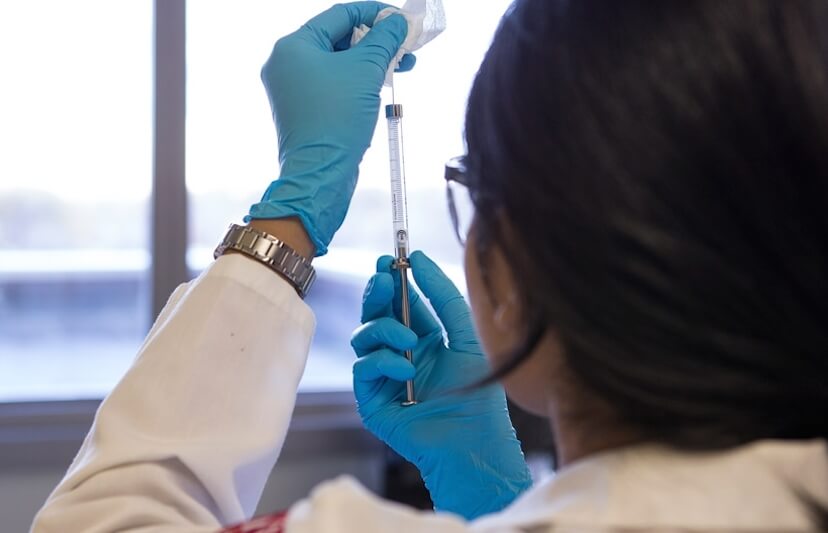A team of scientists from the Lewis Katz School of Medicine at Temple University has developed a method to extract HIV DNA from the cells of living animals. With the team’s revolutionary and successful testing, the permanent cure for HIV may finally be within reach.
The team used CRISPR/Cas-9, a gene editing technology, to eliminate cells infected with HIV-1. The team tested the technology in three separate animal models. In what they call a “humanized model,” the scientists transplanted HIV-infected human immune cells into mice and successfully eliminated the virus. This marks the first time scientists were able to eliminate infection in human cells.
The team was led by Wenhui Hu, currently an associate professor in the Center for Metabolic Disease Research and the Department of Pathology (previously in the Department of Neuroscience); Laura H. Carnell Professor of Neuroscience Kamel Khalili, chair of the Department of Neurology and director of the Center for Neurovirology and the Comprehensive NeuroAIDS Center; and Won-Bin Young, who was an assistant professor of radiology at the University of Pittsburgh School of Medicine during the research, but recently joined Temple’s medical school as a senior research scientist.
TUN spoke with Dr. Khalili to gain insight on the research. He believes we are finally at a stage where there could be a cure for AIDS.
With more than 30 years of research experience in HIV, I believe we have reached a stage where the technologies are available for developing effective strategies, including the use of gene editing, perhaps in combination with other currently available methods, for the cure of AIDS.
Currently, antiretroviral drugs (ARV) are used to treat those infected with HIV. The problem is, the use of ARVs is a treatment and not a cure. They can prevent the growth of the virus, but can’t mend damage already inflicted by HIV, or eliminate the virus altogether. ARV therapy (cART) is expensive and HIV rebounds if patients suspends their therapy. When the virus spreads and the number of CD4 cells drops below 200 cells per cubic millimeter of blood, the HIV virus develops into AIDS.
The team’s initial studies were conducted on rats and mice. Every genome of every cell and organ of the animals was infected with HIV-1. The team of scientists then put in place a recombinant adeno-associated viral (rAAV) vector delivery system. This enabled the insertion of CRISP/Cas-9 molecules into the bloodstream of the infected animals. When the animals’ DNA was analyzed two weeks later, the results were astounding. There was no trace of HIV-1 in the genome of any infected tissue.
Recent studies backed up the results of the team’s initial research. “Our new study is more comprehensive,” Hu said in a statement. “We confirmed the data from our previous work and have improved the efficiency of our gene editing strategy. We also show that the strategy is effective in two additional mouse models, one representing acute infection in mouse cells and the other representing chronic, or latent, infection in human cells.”
What’s next?
Khalili feels positive that the team could get to clinical trials a year from now if they can secure funding to proceed with their next step. “The next step is to complete our preclinical and toxicity studies before entering into clinical trials,” said Khalili. “We hope we can accomplish this within a year and we should then be in a position to enter clinical trials. The barriers that hold back clinical testing are funding for the studies.”
Khalili told TUN that some of the past research was funded by grants from the National Institutes of Health (NIH), but a grant awarded to Hu and Khalili had just ended. While they still have access to NIH-funded grant to the P30 Comprehensive NeuroAIDS Center, which was awarded to Khalili and some of his colleagues, they can’t use the funds to proceed with the next step for the current study. “NIH research grants do not typically cover funds for the types of preclinical and toxicity studies that need to be done in order to move to the clinic,” said Khalili.
The World Health Organization reports that since the HIV virus was first discovered in 1983, it has infected more than 70 million people and killed 35 million. By the end of 2015 there were 36.7 million people living with HIV, globally. In Sub-Saharan Africa every 1-25 adults are infected with the virus.
This current breakthrough could eliminate the HIV virus altogether, if the team’s success with mice continues with primates and eventually humans. The team of researchers has future goals to “repeat the study in primates, a more suitable animal model where HIV infection induces disease, in order to further demonstrate elimination of HIV-1 DNA in latently infected T cells and other sanctuary sites for HIV-1, including brain cells,” Dr. Khalili said in a statement. “Our eventual goal is a clinical trial in human patients.”



